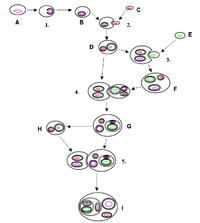
Antagonistic interaction between male‐killing and cytoplasmic incompatibility induced by Cardinium and Wolbachia in the whitefly, Bemisia tabaci
Sign Up to like & getrecommendations! Published in 2020 at "Insect Science"
DOI: 10.1111/1744-7917.12793
Abstract: Cardinium and Wolbachia are maternally inherited bacterial symbionts of arthropods that can manipulate host reproduction by increasing the fitness of infected females. Here, we report that Cardinium and Wolbachia coinfection induced male‐killing and cytoplasmic incompatibility… read more here.
Keywords: cardinium wolbachia; cardinium; male killing; asia ii7 ... See more keywords

Heterogeneous distribution of Cardinium in whitefly populations is associated with host nuclear genetic background.
Sign Up to like & getrecommendations! Published in 2023 at "Insect science"
DOI: 10.1111/1744-7917.13199
Abstract: Inherited bacterial symbionts are very common in arthropods, but infection frequency can vary widely among populations. Experiments and interpopulation comparisons suggest that host genetic background might be important in explaining this variation. Our extensive field… read more here.
Keywords: associated host; nuclear genetic; cardinium; genetic background ... See more keywords

Identifying potential candidate Culicoides spp. for the study of interactions with Candidatus Cardinium hertigii
Sign Up to like & getrecommendations! Published in 2021 at "Medical and Veterinary Entomology"
DOI: 10.1111/mve.12517
Abstract: Culicoides biting midges (Diptera: Ceratopogonidae) are vectors responsible for the transmission of several viruses of veterinary importance. Previous screens of Culicoides have described the presence of the endosymbiont Candidatus Cardinium hertigii (Bacteroidetes). However, any impacts… read more here.
Keywords: cardinium; study; candidatus cardinium; cardinium hertigii ... See more keywords

Stable Establishment of Cardinium spp. in the Brown Planthopper Nilaparvata lugens despite Decreased Host Fitness
Sign Up to like & getrecommendations! Published in 2019 at "Applied and Environmental Microbiology"
DOI: 10.1128/aem.02509-19
Abstract: In this study we established a Cardinium-infected N. lugens line that possessed complete maternal transmission. Cardinium had a widespread distribution in tissues of N. lugens, and this infection decreased the fecundity and hatching rate of… read more here.
Keywords: brown planthopper; cardinium; nilaparvata lugens; planthopper nilaparvata ... See more keywords

Endogenous Plasmids and Chromosomal Genome Reduction in the Cardinium Endosymbiont of Dermatophagoides farinae
Sign Up to like & getrecommendations! Published in 2023 at "mSphere"
DOI: 10.1128/msphere.00074-23
Abstract: As bacterial endosymbionts, Cardinium typically undergoes genome reduction, but the molecular process is still unclear, such as how plasmids get involved in chromosome reduction. Here, we de novo assembled 2 genomes of Cardinium in astigmatic… read more here.
Keywords: cardinium; chromosomal genome; endogenous plasmids; cardinium endosymbiont ... See more keywords

Interactions of the Intracellular Bacterium Cardinium with Its Host, the House Dust Mite Dermatophagoides farinae, Based on Gene Expression Data
Sign Up to like & getrecommendations! Published in 2021 at "mSystems"
DOI: 10.1128/msystems.00916-21
Abstract: The molecular mechanisms of mite-symbiont interactions and their impacts on human health are largely unknown. Astigmatid mites, such as house dust and stored-product mites, are among the most significant allergen sources worldwide. ABSTRACT Dermatophagoides farinae… read more here.
Keywords: expression; cardinium; bacterium; mite ... See more keywords

Bacterial endosymbiont Cardinium cSfur genome sequence provides insights for understanding the symbiotic relationship in Sogatella furcifera host
Sign Up to like & getrecommendations! Published in 2018 at "BMC Genomics"
DOI: 10.1186/s12864-018-5078-y
Abstract: BackgroundSogatella furcifera is a migratory pest that damages rice plants and causes severe economic losses. Due to its ability to annually migrate long distances, S. furcifera has emerged as a major pest of rice in… read more here.
Keywords: cardinium csfur; bacterial endosymbiont; host; furcifera ... See more keywords

Distribution of Bacterial Endosymbionts of the Cardinium Clade in Plant-Parasitic Nematodes
Sign Up to like & getrecommendations! Published in 2023 at "International Journal of Molecular Sciences"
DOI: 10.3390/ijms24032905
Abstract: Bacteria of the genus “Candidatus Cardinium” and related organisms composing the Cardinium clade are intracellular endosymbionts frequently occurring in several arthropod groups, freshwater mussels and plant-parasitic nematodes. Phylogenetic analyses based on two gene sequences (16S… read more here.
Keywords: parasitic nematodes; endosymbionts cardinium; cardinium; cardinium clade ... See more keywords

The draft genome of strain cCpun from biting midges confirms insect Cardinium are not a monophyletic group and reveals a novel gene family expansion in a symbiont
Sign Up to like & getrecommendations! Published in 2019 at "PeerJ"
DOI: 10.7717/peerj.6448
Abstract: Background It is estimated that 13% of arthropod species carry the heritable symbiont Cardinium hertigii. 16S rRNA and gyrB sequence divides this species into at least four groups (A–D), with the A group infecting a… read more here.
Keywords: symbiont; group; ccpun; cardinium ... See more keywords